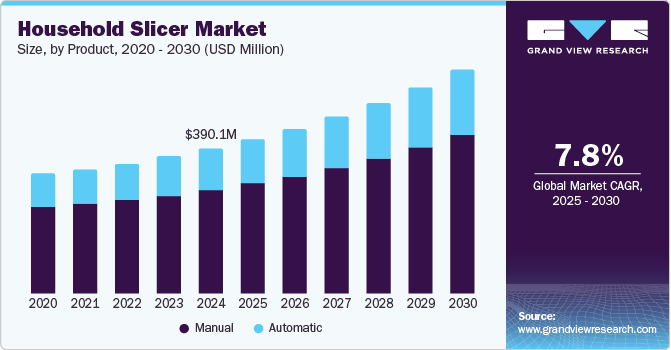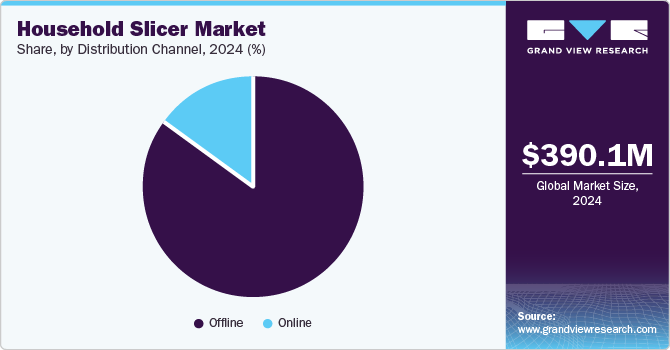
Household Slicer Market Size, Share & Trends Analysis Report By Product (Manual, Automatic), By Distribution Channel (Offline, Online), By Region (Europe, MEA, APAC), And Segment Forecasts, 2025 - 2030
- Report ID: GVR-4-68039-126-6
- Number of Report Pages: 100
- Format: PDF, Horizon Databook
- Historical Range: 2018 - 2023
- Forecast Period: 2025 - 2030
- Industry: Consumer Goods
Household Slicer Market Size & Trends
The global household slicer market size was valued at USD 390.1 million in 2024 and is expected to grow at a CAGR of 7.8% from 2025 to 2030. This growth is attributed to increasing demand for efficient kitchen appliances, trend of home cooking, and popularity of online shopping. As more consumers prioritize convenience and quality in their cooking tools, household slicers have become essential for meal preparation, making them a staple in modern kitchens.

The shift toward home cooking has increased the demand for convenient and time-saving kitchen solutions and is one of the primary drivers of the household slicer industry. A wide range of kitchen appliances that enhance cooking efficiency and improve cooking experience are available in the market. For instance, automatic slicers offer speed and precision and are becoming increasingly popular among consumers looking to save time while preparing meals. This shift is expected to boost sales and encourage manufacturers to innovate and improve their products.
In addition, the growing trend of healthy eating has influenced consumer inclination toward purchasing household slicers. As people become more health-conscious, they seek convenient ways to prepare fresh fruit and vegetable salads. Slicers enable users to create uniform slices for salads, sandwiches, and other dishes, promoting healthier eating habits. The versatility of these appliances makes them suitable for various culinary needs, further driving the household slicer industry.
Technological advancements have led to the development of smarter and more efficient household slicers. Features such as adjustable thickness settings and safety mechanisms appeal to consumers who prioritize ease of use and safety in their kitchen tools. For instance, electric slicers equipped with advanced blade technology can slice through various food items effortlessly, attracting a broader customer base. Innovations in product designs to align them with consumer requirements are likely to contribute significantly to the growth of the household slicer industry over the coming years.
Product Insights
The manual segment held the largest revenue share of 71.9% in the household slicer industry in 2024, primarily due to its affordability and ease of use. Many consumers prefer manual slicers as they offer precise control over slicing thickness, which is essential for achieving desired culinary results. In addition, the wide availability of manual slicers at various price points makes them accessible to a broader audience, including budget-conscious consumers. Home cooks often choose manual slicers to prepare ingredients for popular dishes showcased in cooking shows, such as MasterChef, as these slicers allow them to replicate slicing techniques shown on such shows and used by food bloggers.
The automatic segment is expected to grow at the highest CAGR over the forecast period, driven by the increasing demand for convenience and efficiency in food preparation. Consumers leading busier lives prefer advanced kitchen appliances such as automatic slicers that save time and effort. These tools are equipped with advanced features such as adjustable slicing thickness and safety mechanisms, enhancing user experience and safety. For instance, a family preparing meals for gatherings can benefit from an automatic slicer that quickly and uniformly slices vegetables for salads or sandwiches, significantly reducing the prep time.
Distribution Channel Insights
The offline segment held the largest revenue share in the household slicer industry in 2024, owing to the tactile shopping experience it offers consumers. Many buyers prefer to physically inspect and test kitchen appliances before purchasing, ensuring they meet their quality and functionality expectations. Retail stores provide immediate access to various products, allowing customers to easily compare quality, features, and prices. For instance, a customer looking for a slicer might visit a local kitchenware store to check different models, assessing their weight, grip, design, and ease of use.

The online segment is expected to grow at the highest CAGR over the forecast period, driven by the increasing convenience and accessibility offered by e-commerce platforms. Consumers are increasingly opting for online shopping as a wider selection of products is available at competitive prices. This trend is appealing to younger consumers who are comfortable with technology and prefer to shop from home for the ease of access and time-saving benefits offered by online portals. The popularity of food blogging is inspiring consumers to try new recipes, share their culinary experiences online, and contribute to product reviews, making them more likely to purchase cooking tools such as household slicers through digital channels.
Regional Insights
The North America household slicer market dominated with the largest revenue share of 33.4% in 2024, primarily due to the region's strong consumer preference for high-quality kitchen appliances and growing interest in home cooking and culinary experimentation. Cooking shows and social media influencers have amplified the popularity of home cooking and contributed to the market expansion. For instance, many individuals are inspired to replicate gourmet recipes at home, leading them to invest in efficient and stylish slicers that enhance their cooking experience. Furthermore, North American consumers increasingly favor durable materials, such as stainless steel, for their kitchen tools, as these offer longevity and ease of use.

U.S. Household Slicer Market Trends
The U.S. household slicer market dominated North America in 2024, driven by consumer preferences, lifestyle changes, and an increasing focus on home cooking. This shift has led to a heightened demand for kitchen appliances that enhance the efficiency of cooking. For instance, many households have invested in electric slicers to quickly prepare ingredients for family meals or gatherings, reflecting a trend toward convenience and quality in-home cooking. In addition, the U.S. market benefits from a robust retail infrastructure and a wide range of product offerings from established brands, making it easier for consumers to access high-quality slicers tailored to their specific needs.
Asia Pacific Household Slicer Market Trends
The Asia Pacific household slicer market is expected to grow at the highest CAGR over the forecast period, driven by rapid urbanization and a growing middle-class population with increasing disposable income. As more consumers in this region adopt a Westernized lifestyle, the demand for modern kitchen appliances that facilitate efficient food preparation is expected to surge. In countries such as India and China, where home cooking is prevalent, households are investing in slicers to enhance their culinary capabilities and replicate international cuisines. Diverse culinary traditions across the Asia Pacific are expected to further propel the demand for various types of slicers, such as electric slicers for meats or manual slicers for vegetables, tailored to specific food preparation needs.
The China household slicer market dominated Asia Pacific in 2024 with the largest revenue share, due to increased urbanization, where consumers are investing in kitchen appliances that enhance their cooking experience, leading to greater demand for household slicers. For instance, many households in the country are adopting Western culinary practices, which often require precise slicing techniques for dishes such as salads and sandwiches. This shift is exemplified by the growing popularity of online cooking classes that showcase international cuisines, prompting consumers to purchase slicers for better meal preparation. In addition, the availability of a wide range of affordable and high-quality slicers in local markets further boosts sales, making these appliances accessible to a broader audience base.
Europe Household Slicer Market Trends
Europe household slicer market is expected to grow significantly over the forecast period, due to increasing emphasis on home cooking and the rising awareness about the benefits of healthy eating habits. As consumers become more health-conscious, there is a growth in demand for fresh, homemade meals, which encourages the use of kitchen tools that facilitate food preparation. In addition, the trend of hosting social gatherings and dinner parties has elevated the interest in culinary skills, prompting consumers to purchase tools that enhance their cooking experience. The availability of innovative and user-friendly slicers and the rise of e-commerce platforms offering diverse options are further expected to support market growth.
Key Household Slicer Company Insights
Some key players in the household slicer market are MHS Schneidetechnik GmbH, Swedlinghaus Srl, Foodmate, MAGURIT Gefrierschneider GmbH, Brunner Group, HALLDE, Bizerba SE & Co. KG, Deville Technologies, Sirman S.p.A., and Weber Food Technology GmbH. These companies in the household slicer market follow various strategies to enhance their competitive position, focusing on innovation and customer-centric product development. They prioritize the introduction of advanced slicers that improve efficiency and ease of use, catering to the growing demand for convenient kitchen appliances.
-
Bizerba SE & Co. KG specializes in advanced slicing technologies, providing a comprehensive range of slicers designed for various food applications. For instance, its fully automatic A 660 industrial slicer integrates features such as precise portioning and intelligent motor control to enhance efficiency and minimize waste.
-
MHS Schneidetechnik GmbH focuses on developing high-quality slicing machines that cater to the diverse needs of the food processing industry. Its products are engineered for precision and reliability and feature advanced technology that offers customizable slicing options tailored to specific food types.
Key Household Slicer Companies:
The following are the leading companies in the household slicer market. These companies collectively hold the largest market share and dictate industry trends.
- MHS Schneidetechnik GmbH
- Swedlinghaus Srl
- Foodmate
- Brunner Group
- HALLDE
- Bizerba SE & Co. KG
- Sirman S.p.A.
- Deville Technologies
- MAGURIT Gefrierschneider GmbH
- Weber Food Technology GmbH
View a comprehensive list of companies in the Household Slicer Market
Recent Developments
-
In December 2024, HALLDE introduced a comprehensive range of cutting tools specifically designed for their Combi Cutters and Vegetable Preparation machines, which are ideal for household slicing needs. These tools feature high-quality stainless-steel blades that are dishwasher safe, ensuring both durability and convenience for home cooks. HALLDE also provides options for exchangeable knife blades, knife balks, and plates, making it easy for users to find the necessary spare parts to maintain their kitchen equipment efficiently. This commitment to quality and functionality enhances the cooking experience for households looking to simplify food preparation.
Household Slicer Market Report Scope
|
Report Attribute |
Details |
|
Market size value in 2025 |
USD 414.6 million |
|
Revenue forecast in 2030 |
USD 603.6 million |
|
Growth rate |
CAGR of 7.8% from 2025 to 2030 |
|
Base year for estimation |
2024 |
|
Historical data |
2018 - 2023 |
|
Forecast period |
2025 - 2030 |
|
Report updated |
December 2024 |
|
Quantitative units |
Revenue in USD million and CAGR from 2025 to 2030 |
|
Report coverage |
Revenue forecast, company ranking, competitive landscape, growth factors, and trends |
|
Segments covered |
Product, Distribution Channel, and Region |
|
Regional scope |
North America, Europe, Asia Pacific, Latin America, MEA |
|
Country scope |
U.S., Canada, Mexico, Germany, UK, France, Italy, Spain, China, Japan, India, Australia, South Korea, Brazil, Saudi Arabia |
|
Key companies profiled |
MHS Schneidetechnik GmbH, Swedlinghaus Srl, Foodmate, MAGURIT Gefrierschneider GmbH, Brunner Group, HALLDE, Bizerba SE & Co. KG, Deville Technologies, Sirman S.p.A., Weber Food Technology GmbH |
|
Customization scope |
Free report customization (equivalent up to 8 analysts working days) with purchase. Addition or alteration to country, regional & segment scope. |
|
Pricing and purchase options |
Avail customized purchase options to meet your exact research needs. Explore purchase options |
Global Household Slicer Market Report Segmentation
This report forecasts revenue growth at global, regional, and country levels and provides an analysis of the latest industry trends in each of the sub-segments from 2018 to 2030. For this study, Grand View Research has segmented the global household slicer market report based on product, distribution channel, and region:

-
Product Outlook (Revenue, USD Million, 2018 - 2030)
-
Manual
-
Automatic
-
-
Distribution Channel Outlook (Revenue, USD Million, 2018 - 2030)
-
Offline
-
Online
-
-
Regional Outlook (Revenue, USD Million, 2018 - 2030)
-
North America
-
U.S.
-
Canada
-
Mexico
-
-
Europe
-
Germany
-
UK
-
France
-
Italy
-
Spain
-
-
Asia Pacific
-
China
-
Japan
-
India
-
Australia
-
South Korea
-
-
Latin America
-
Brazil
-
-
Middle East and Africa (MEA)
-
Saudi Arabia
-
-
We are committed towards customer satisfaction, and quality service.
"The quality of research they have done for us has been excellent."




